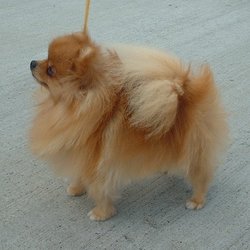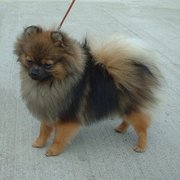Pomeranian
|
|
| Pomeranian | |||||||||||||||||||||
|---|---|---|---|---|---|---|---|---|---|---|---|---|---|---|---|---|---|---|---|---|---|
| Alternative names | |||||||||||||||||||||
| |||||||||||||||||||||
| Country of origin | |||||||||||||||||||||
| Poland and Germany | |||||||||||||||||||||
| Common nicknames | |||||||||||||||||||||
| |||||||||||||||||||||
| Classification and breed standards | |||||||||||||||||||||
|
The Pomeranian is a breed of dog in the spitz family, named for the Pomerania region of Poland and East Germany, and classed as a toy dog breed because of its small size.
| Contents |
Appearance
At 3 to 7 lb (1.4 to 3.2 kg) according to AKC standards, the Pomeranian (Pom) is the most diminutive of the northern breeds.
The head of the Pomeranian is wedge-shaped, making it somewhat foxy in appearance. The ears are small and pointed. Its tail is characterstic of the breed and should be be turned over the back and carried flat, set high.
The Pom's coat is its glory, two coats, an undercoat and a top coat; the first is soft, thick, and fluffy; the latter is a long, perfectly straight and glistening coat covering the whole body. The undercoat is shed during warm weather conditions.
The AKC recognizes twelve colors or color combinations: black, brown, chocolate, beaver, red, orange, cream, orange-sable, wolf-sable, blue, white, and parti-color.
Temperament
The Pom is an active dog who is intelligent, courageous, and a loyal companion. The Pomeranian may not interact well with small children and due to its small size can suffer abuse from children .
Pomeranians have proven themselves to be excellent watchdogs by announcing intruders with loud, sharp barks.
The Pomeranian easily adapts to life in the city, and is an excellent dog for country living with its strong hunting instincts from its wild ancestors.
History
The Pomeranian originated from the sled dogs of Iceland and Lapland, which were eventually brought into Europe. The Germans improved the coat and bred the dogs down for city living, but they were still 20 pounds or more when they reached England.
English breeders, through trial and error and Mendelian theories, are credited for reducing the dog's size and developing the many colors. The Pomeranian of today is small due to selective breeding, but the breed still retains the hardy disposition and thick coat typical of dogs in cold climates.
The Pomeranian became internationally popular when Queen Victoria returned from vacation in Florence, Italy with a Pomeranian named Marco.
The closest relatives of the Pomeranian are the Norwegian Elkhound, the Samoyed, the Schipperke, and the whole Spitz group.
Health
Pomeranians are generally a healthy, hardy, and long-lived breed—often, Poms live 15 or 16 years.
The teeth of the Pomeranian can be the cause of serious health concerns for the breed. The teeth must be meticulously cared for through frequent cleaning to prevent the teeth from falling out at a rather early age. Problems with the teeth can cause heart problems which may lead to an early death.
Another common ailment is a dislocated patella.
Miscellaneous
Famous Pomeranians
- Chester Drescher
- Sharon Osbourne's Pomeranian, Mimi
Dog Pictures and Clipart
- Pictures of Dogs (http://classroomclipart.com/cgi-bin/kids/imageFolio.cgi?direct=Animals/Dogs)
- Dog Clipart (http://classroomclipart.com/cgi-bin/kids/imageFolio.cgi?direct=Clipart/Animals/Dog_Clipart)
Clipart and Animal Pictures
- Clipart (https://classroomclipart.com/image/category/clipart.htm)
- Animal Clipart (https://classroomclipart.com/image/category/animal-clipart.htm)
- Animal Animated Clipart (https://classroomclipart.com/clipart/Animations/Animals.htm)
- Pictures of Animals (https://classroomclipart.com/image/category/animal-photos.htm)
- Amphibian Clip Art, Pictures and Photogaphs (https://classroomclipart.com/image/category/amphibian-clipart.htm)
- Farm Animal Clip Art, Pictures and Photographs (https://classroomclipart.com/image/category/farm-animal-clipart.htm)
- Mammal Clip Art, Pictures and Photographs (https://classroomclipart.com/image/category/mammal-clipart.htm)
- Marine Animal Clip Art, Pictures and Photographs (https://classroomclipart.com/image/category/marine-life-clipart.htm)
- Reptile Clip Art, Pictures and Photographs (https://classroomclipart.com/image/category/reptile-clipart.htm)
- Spider Clip Art, Pictures and Photographs (https://classroomclipart.com/image/category/spider-clipart.htm)




